Great choice! Your favorites are temporarily saved for this session. Sign in to save them permanently, access them on any device, and receive relevant alerts.
- Sailboat Guide

Etchells Class
Etchells Class is a 30 ′ 6 ″ / 9.3 m monohull sailboat designed by E. W. (Skip) Etchells and built by Sydney Yachts/Bashford Int., Ontario Yachts, Robertson and Sons Ltd., David Heritage Racing Yachts, and Petticrows starting in 1966.

Rig and Sails
Auxilary power, accomodations, calculations.
The theoretical maximum speed that a displacement hull can move efficiently through the water is determined by it's waterline length and displacement. It may be unable to reach this speed if the boat is underpowered or heavily loaded, though it may exceed this speed given enough power. Read more.
Classic hull speed formula:
Hull Speed = 1.34 x √LWL
Max Speed/Length ratio = 8.26 ÷ Displacement/Length ratio .311 Hull Speed = Max Speed/Length ratio x √LWL
Sail Area / Displacement Ratio
A measure of the power of the sails relative to the weight of the boat. The higher the number, the higher the performance, but the harder the boat will be to handle. This ratio is a "non-dimensional" value that facilitates comparisons between boats of different types and sizes. Read more.
SA/D = SA ÷ (D ÷ 64) 2/3
- SA : Sail area in square feet, derived by adding the mainsail area to 100% of the foretriangle area (the lateral area above the deck between the mast and the forestay).
- D : Displacement in pounds.
Ballast / Displacement Ratio
A measure of the stability of a boat's hull that suggests how well a monohull will stand up to its sails. The ballast displacement ratio indicates how much of the weight of a boat is placed for maximum stability against capsizing and is an indicator of stiffness and resistance to capsize.
Ballast / Displacement * 100
Displacement / Length Ratio
A measure of the weight of the boat relative to it's length at the waterline. The higher a boat’s D/L ratio, the more easily it will carry a load and the more comfortable its motion will be. The lower a boat's ratio is, the less power it takes to drive the boat to its nominal hull speed or beyond. Read more.
D/L = (D ÷ 2240) ÷ (0.01 x LWL)³
- D: Displacement of the boat in pounds.
- LWL: Waterline length in feet
Comfort Ratio
This ratio assess how quickly and abruptly a boat’s hull reacts to waves in a significant seaway, these being the elements of a boat’s motion most likely to cause seasickness. Read more.
Comfort ratio = D ÷ (.65 x (.7 LWL + .3 LOA) x Beam 1.33 )
- D: Displacement of the boat in pounds
- LOA: Length overall in feet
- Beam: Width of boat at the widest point in feet
Capsize Screening Formula
This formula attempts to indicate whether a given boat might be too wide and light to readily right itself after being overturned in extreme conditions. Read more.
CSV = Beam ÷ ³√(D / 64)
Originally called the E22 or ETCHELLS 22. Renamed ETCHELLS CLASS in 1990. The prototype ‘Shililah’, was built to compete in the IYRU 3 man keel boat trials of 1966. Despite winning nearly every race, another boat, (the SOLING), was ultimately selected and became the 3 man keel boat Olympic class. The enthusiasm for the new design grew just the same and the ETCHELLS CLASS became one of the most successful international one-design classes.
Embed this page on your own website by copying and pasting this code.
- About Sailboat Guide
©2024 Sea Time Tech, LLC
This site is protected by reCAPTCHA and the Google Privacy Policy and Terms of Service apply.
- Classics incl Quarter Tonners
International Etchells

David Heritage Racing Yachts is one of only three boatyards worldwide with a licence to build the International Etchells. The International Etchells strict one-design principle was established from the outset and is controlled by a strong, well-administered Class Association.
The hull is constructed with premium high performance resins and glass cloth, which combined with accurate temperature controlled post curing techniques, ensures quality and a long, trouble free hull life. Control of construction ensures quality and uniformity. The Etchells fast, stable and sleek design enables it to be sailed comfortably and competitively.
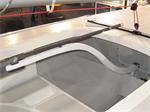
Dimensions Overall length 9.29 m Waterline length 6.70 m Beam 2.12 m Draft 1.37 m Displacement 1.564 tonnes Mainsail area 20m2 Genoa area 8.5m2 Spinnaker area 48m2
Specification
Hull and Deck High quality controlled hand lay-up using the best resin and glass cloth from ISAF approved moulds in temperature controlled workshop and post cured to resin manufacturer’s specification to ensure maximum hull and deck stiffness.
Colours White/light grey
Specials Double action bilge pump fitted on mast beam, glass tiller and easy adjusted mast rake system fitted as standard.
Foils Fully optimised shape within class rules.
Fit out Using top quality ball bearing blocks and cleats. Machine tapered main, jib and spinnaker sheets. TackTic micro compass, safety equipment to class rules.
Rig Mast, boom and spinnaker pole from Selden Masts, fully rigged with Dyform standing rigging and calibrated turnbuckles, 1 x 19 wire running rigging and Spectra spinnaker halyard adjustable mast step fitted as standard. Other rig combinations are available.
David Heritage is a agent for Doyle Sails. Please enquire for prices. North Sails Website
We have a number of second hand Etchells sails available – please enquire for a list or click here for our brokerage .
There are some excellent tuning and video guides with David Bedford on the Etchells Fleet UK site. Click here to view these Class Associations: International Etchells Class Association UK Class Association
Next regatta: Winter Champs, 8 - 10 Jun
Item added to your cart

COME SAIL WITH US
In the leading one design keel boat for level playing field racing, club, state, national, worldwide — Etchells
World Championship updates from Fremantle
Tune in to the excellent media coverage coming out from Fremantle, Western Australia. Results, news, photos, video, race tracker!
Magpie swooping more of the prizes, WA States
The upcoming Worlds race course was tested in the WA States, sailing off Fremantle, south of Perth. One team seem hard to beat with recent nest full of trophies.
Ireland Girl, Victorian State Champions
All over the place winds, 1.5 to 16 knots, and over 30 knots on the first abandoned day, brought some challenging conditions.
UPCOMING EVENTS
Australasian winter championship round 1.
8 – 10 June 2024
Coffs Harbour Yacht Club
AUSTRALASIAN WINTER CHAMPIONSHIP ROUND 2
22 – 23 June 2024
AUSTRALASIAN WINTER CHAMPIONSHIP ROUND 3
6 – 7 July 2024
GOLD COAST CHAMPIONSHIP
20 – 21 July 2024
Gold Coast Fleet
Southport Yacht Club
MICK HOLE REGATTA
Pittwater Fleet
Royal Prince Alfred Yacht Club
Regatta website
Help fund development & promotion of the class, joining qualifies you for racing in our championship regattas, and fleet numbers help Australian representation at the International level.
Join or renew your membership with Etchells Australia. Etchells owners and their crew (associates) can join online, choose your fleet from the list.

- Choosing a selection results in a full page refresh.
- Opens in a new window.

- CLASSIFIEDS
- NEWSLETTERS
- SUBMIT NEWS

2024 Etchells World Championships at Fremantle Sailing Club - Day 1
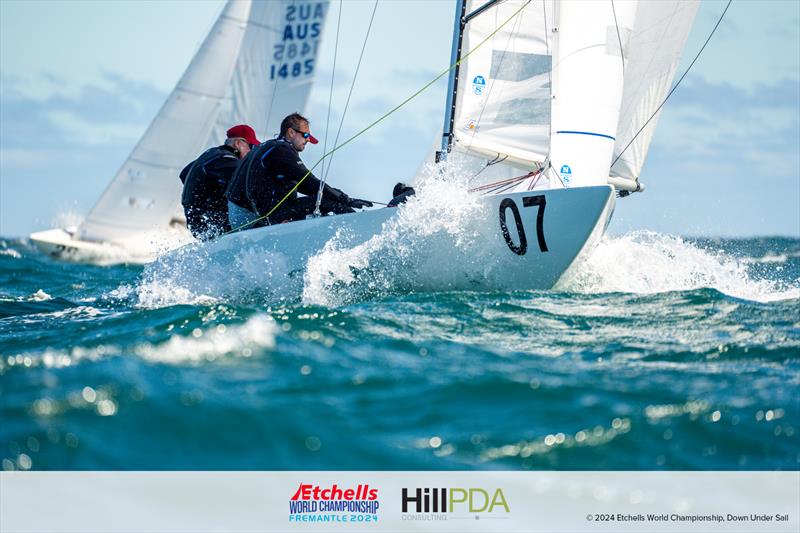
Related Articles

- New Sailboats
- Sailboats 21-30ft
- Sailboats 31-35ft
- Sailboats 36-40ft
- Sailboats Over 40ft
- Sailboats Under 21feet
- used_sailboats
- Apps and Computer Programs
- Communications
- Fishfinders
- Handheld Electronics
- Plotters MFDS Rradar
- Wind, Speed & Depth Instruments
- Anchoring Mooring
- Running Rigging
- Sails Canvas
- Standing Rigging
- Diesel Engines
- Off Grid Energy
- Cleaning Waxing
- DIY Projects
- Repair, Tools & Materials
- Spare Parts
- Tools & Gadgets
- Cabin Comfort
- Ventilation
- Footwear Apparel
- Foul Weather Gear
- Mailport & PS Advisor
- Inside Practical Sailor Blog
- Activate My Web Access
- Reset Password
- Customer Service

- Free Newsletter

Pearson Rhodes 41/Rhodes Bounty II Used Sailboat Review

Hallberg-Rassy 42 Used Sailboat Review

How to Perform Your Own Pre-Buy Inspection

Beneteau 323 Used Boat Review

Thinking Through a Solar Power Installation

How Does the Gulf Stream Influence our Weather?

Can You Run a Marine Air-Conditioner on Battery Power?

Preparing Yourself for Solo Sailing


Practical Sailor Classic: The Load on Your Rode

Anchor Rodes for Smaller Sailboats

Ground Tackle Inspection Tips

Shoe Goo II Excels for Quick Sail Repairs
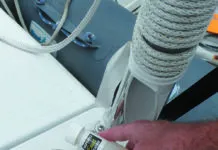
Diesel Performance Additives

What Oil Analysis Reveals About Your Engine
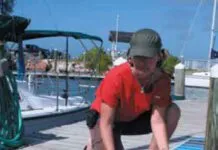
The Best Tools for Bottom Painting
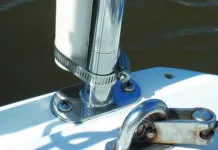
The Hidden Maintenance Problems That Can Ruin Your Day: Part 1

Bottom Paint 30-Month Update

Battle of the Teak Cleaners — Snappy Teak-Nu vs. Star Brite

Are E-bikes Worth the Extra Weight and Cost?

How to Select Crew for a Passage or Delivery

Preparing A Boat to Sail Solo

Re-sealing the Seams on Waterproof Fabrics

Waxing and Polishing Your Boat

Reducing Engine Room Noise

Tricks and Tips to Forming Do-it-yourself Rigging Terminals

Marine Toilet Maintenance Tips

Learning to Live with Plastic Boat Bits
- Sailboat Reviews
Etchells-inspired e33 – A Practical Sailor New Sailboat Review
The first-ever robbie doyle-jeremy wurmfeld collaboration balances performance sailing with basic comforts in this modern daysail boat..
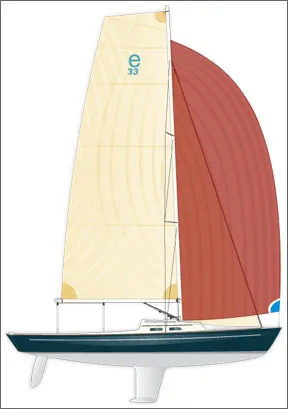
Photos courtesy of e Sailing Yachts
The trophy daysailer market is rife with branding, image, and various forms of snob appeal. The e33, however, makes its pitch on practical grounds. Reports from the field highlight the performance/comfort/control combination that makes the e33 a fun raceboat. You don’t need a big crew, you can exercise your tactical talents to the max, and you give away nothing in boatspeed. Our time sailing the e33 convinced us that it is not only a legitimate performance sailboat, but that attaining that performance is sinfully easy. The e33 daysailers bonus points include a cockpit that takes up more than half the deck space and can hold five or six adults comfortably; cockpit-led control lines; carbon-fiber spars; and a hydraulic headstay control. Below, Spartan accommodations include berths for four, an enclosed head, and a built-in cooler. With the look of a classic and the innovative design of a modern daysailer, the e33 is e Sailing Yachts intelligent, inspired, comprehensive attempt to capture the fun of performance sailing.
****
With 50 lofts in 30 countries, you might think that Robbie Doyle, founder and president of Doyle Sailmakers, would have more than enough to keep him busy. Nonetheless, hes leapt into boatbuilding. Partnered with designer Jeremy Wurmfeld, Doyle created the e33. One of the many attractive, expensive daysailers to hit the market recently, this 33-footer has minimal accommodations, a 16-foot cockpit, and a host of solutions and innovations.
Doyle remembers how the e33 came about: “Dirk Kneulman (Etchells builder and former world champion), Jeremy, and I were fantasizing about a boat that would be as much fun to sail as the Etchells without the bumps and bruises, a performance boat that could be sailed to the max with no hiking, a boat that gives you no excuse not to sail.” A college All-American (Harvard 1971), Doyle apprenticed with Ted Hood early in his career, spent significant time pursuing The America s Cup, then founded Doyle Sailmakers in 1982. “Much of my course work was in naval architecture at MIT,” he explained. That background, he asserts, not only taught him the basics of boat design, but influenced his approach to sails. Utilizing the principles of elliptical loading demonstrated in the famous Australian wing keel in 1983, Doyle became the first to apply the principle of Elliptical Aerodynamic Loading to sail shapes. The e33 thus grew out of Doyles racing experience, his feel for what sailors want, his understanding of technology, and his capacity for innovation (Stack Pack, Quicksilver reefing, etc.).
Wurmfeld was trained in conventional architecture. After a short time on the job, however, he bolted his desk to become a charter skipper in the Caribbean. After that, he came ashore to enroll in naval architecture at Westlawn Institute of Marine Technology. That degree led to a six-year stint at Sparkman & Stephens before he went out on his own in 2004. Wurmfeld also has raced Etchells on Long Island Sound for years.
Kneulman (Ontario Yachts), who builds Sonars as well as Etchells, decided not to build e33s, despite his involvement in the boats development. That led Doyle and company to Waterlines Systems of Portsmouth, R.I. Small but diversified, Waterlines has specialized in “one-design optimization” and also builds J-22s, J-24s, Farr 40s, and Mumm 30s under license. To date, the company has built more than 20 of the new boats.
The Etchells, a 30-foot, three-man keel racer introduced as a candidate for the Olympics in the mid 1960s, made a stellar starting point for the new design. Originally known as the e22 (for its waterline), the Etchells failed to be chosen for the Games despite dominating the selection trials. There are now more than 50 fleets around the world with more than 1,300 boats actively racing. Rock stars such as Dennis Conner, Jud Smith, and Dave Curtis as well as Kneulman and Doyle attest to the quality of Etchells competition. Called “eternally contemporary” and praised for tacking in 70-degrees and slipping effortlessly through the water, the boat has spawned more than its share of fanatics.
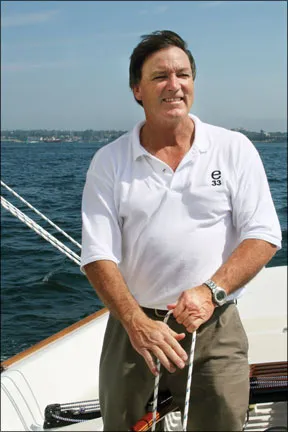
With a ballast/displacement ratio of 63 percent, Etchells are very stiff, Wurmfeld says. The e33s ballast/displacement number is 43 percent, so it, too, stands up well in a breeze. The boats narrow beam (8 feet, 6 inches) minimizes the effect of weight on the rail; the “no hiking” part of its personality is for real.
“We gave the e33 a proper bulb at the end of a 5-foot, 9-inch keel where its weight pays off,” Wurmfeld says.
Like many of the others vying for the “perfect daysailer” mantle, Doyles boat is better for being bigger. Top speed (projected at better than 10 knots) is unlocked by a generous, 27-foot waterline length. Large overhangs forward and aft help assure that its dry underway.
The biggest benefit of its bigness, though, is its huge cockpit. Deep enough to be supremely secure, it seems to go on forever. From transom to companionway, it offers uncompromised lounging, sailing, and elbow room.
The slender hull has V-sections forward of the keel for weatherliness and wave handling. Relatively slack bilges and an easy run of U-shaped sections aft strike a balance between minimizing parasitic drag and providing lift at high speed. Wurmfeld says the foils also reflect the tension between racing efficiency (deep/high-lift) and daysailing practicality (moderate draft/tracking).
One-design competition is always a possibility, but Performance Handicap Racing Fleet (PHRF) is the boats most-likely arena. It rates 90 with a cruising chute in New England and 103 without.
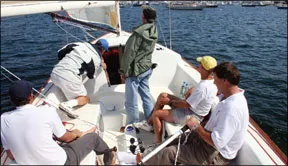
Reports from the field highlight the performance/comfort/control combination that makes the e33 fun to race. You don’t need a big crew, you can exercise your tactical talents to the max, and you give away nothing in boatspeed.
“Starting a new company, we had to beware being all things to all people,” Wurmfeld says. “But the look of the boat was critical. The relationships of masses, shapes, and angles needs to be pleasing to the eye. The counter and transom were my treatment, and Robbie had the last word on the bow angle.”
Like an Etchells, the e33 can be dry-sailed and trailered. At 5,800 pounds, its targeted for the 3-ton lifts at many yacht clubs. “You need a 300-horsepower tow vehicle,” Doyle says. “Strong points for a lifting bridle are built into the boat.”
We asked Doyle if there was a connection between the elliptical aerodynamic loading that he pioneered in the 1980s and the high-roach sailplan of the e33. “When I was building sails for Courageous back in 1977, we tried a high-roach main as an experiment. It became the only main we used that whole summer to win the Cup.”
The textbooks point out that induced drag is minimized by an elliptical (high roach) planform. That makes the ellipse or “Spitfire wing” shape the most efficient outline for a lifting surface, be it wing, keel, or sail. Certainly, sailboards and multihulls have gone heavily in the “fat-head” direction. With the advent of carbon-fiber spars (which Doyle labels “hard not to tune”), masts can now be made stiff enough to stand without a backstay. That, plus refinements in full-length batten technology let monohulls like the e33 benefit from elliptical mainsails and the efficiencies they bring.
“We resisted putting battens in our jib, but a (roller-reefable) triangle didnt give enough punch in light air,” Doyle says. Vertical battens (which make for a better-setting, more-versatile sail) let us add roach for more power.”
The e33s recessed furler with control line led to the helm affords a jib that is elegant and ergonomic as well as efficient.
“Because our sail area is more efficient, we need less of it,” says Doyle. “You can handle our jib without a winch. And our center of pressure is lower. That promotes stability. The J-100, for instance, has a mast thats 7 feet taller than ours.”
Crack off the main, and a lot of the boats sail area goes away. The sheet and traveler let you open (or close) the leech optimally via the top batten. Sails are cut full with easy-to-manage systems like the cunningham to flatten them in a breeze. If you are racing, the Sailtec hydraulic headstay assembly forms a single-point rig adjustment that you can massage puff-by-puff. If you are daysailing, you can set it and forget it.

]Not only does the deck take up half the boat, it is unbroken. More comfortable and less silly than the ubiquitous pushpit seats that adorn many of todays auxiliaries, the afterdeck affords room to read, snooze, or veg in security and comfort. If sunbathing were politically correct, you could do it there, too, all without interfering with the steering or working of the boat.
Just forward of the rudder post is a full-width traveler bar. Sited aft where toe-stubbing is no concern, its control lines are nonetheless convenient to the helm. A gracefully laminated gooseneck tiller sweeps from under the traveler forward to the helmsman.
In the center of the cockpit is a raised pod/footrest that houses mainsheet blocks and can accept a table. If you choose to have the available centerline winch, it goes there beneath the head of the tiller. The sturdy molding houses control lines (halyard, jib furler, spinnaker tackline, and self-tacking jibsheet, if you choose that option) and is low enough to be unobtrusive yet substantial enough for foot bracing. Another nice solution.
It doesn’t surprise us that a boat built by a sailmaker should emphasize sailhandling. The gross and fine-tune systems for the main are not afterthoughts. The big blocks have a home in the pod, and the little ones have been incorporated into the main (carbon-fiber) boom. Two-part control for the jib might have been cumbersome, but fairing the blocks for the fine-tuner into a cabintop channel makes the assembly look clean and work well.
Accommodations
Below, youll find “the bare necessities.” Bunks for a cozy family of four, an enclosed head, and cooler complete the list. No galley, no running water, no weight, no worries.
Doyle and his wife, Janet, took the boat on the Eastern Yacht Club cruise. In four nights and five days aboard, she enjoyed “a dry and comfortable cabin with spacious bunks … zero time over a hot stove … and having 18 aboard for cocktails in the cockpit.” Simplified, camping-out cruising has its charms. The e33 can easily provide them.
Performance

The boat has an auxiliary (a 14-horsepower Yanmar diesel with folding prop on a sail drive), but we doubt it will see much use. Open, narrow, light, and maneuverable, the e33 simplifies boathandling (under both sail and power) around docks, moorings, and marinas-an aspect of “performance” that is easily overlooked.
A 2:1 halyard and ball-bearing Ronstan cars for the battens took the strain out of raising the main. With the sail fully hoisted, the cunningham became our prime means of draft control.
The jibs conventional double-sheeting works so well that we wonder why anyone would choose the optional self-tacker. The standard 105-percent jib looks to us more hassle-free and foolproof than the self-tending alternative.
Falling off and running before a moderate souwester out of Marblehead, Mass., we noted how the jib settled into wing-and-wing untended and how comforting it was to have a clear field of vision over the bow. We sat at the rail, the seat, switched sides … there didnt seem to be a bad spot to steer from. There was nothing “corky” about the way it cut the water. There was little wobble as we surged along. Deep, narrow boats have a feel of their own.
Outside the harbor, we lost some of the breeze and picked up a bit of chop as we rounded onto the wind. This is where we expected her to be at her worst: light wind and waves. Did she have the raw sail power to punch through the slop?
With no trial horse in sight and drawing only on seat-of-the-pants approximation, we loosened the headstay and bagged the main a bit. Our acceleration improved as did our speedo numbers. While the e33 lacks the same “power reserve” you might expect from a boat with a taller rig and an overlapping headsail, its ultra-efficient rig and easily driven hull make it more competitive than you might think. An optional Code-O turbocharges the boat in light air.
On the way back to the mooring, the local “harbor hurricane” in the entrance channel bumped the breeze up into the teens. As advertised, an ease of the main and pump on the headstay had us driving through the puffs at better than 8 knots, no hiking necessary. Flat water showed her close-windedness off to advantage; tacking in less than 80 degrees was impressive.
Wending through the crowded mooring field, the e33 was balanced enough to let us bear away without spilling the main, responsive enough to carve tight turns. Several times, we approached from dead downwind and luffed around a moored boat or ball. The narrow hull carries the e33s weight for boatlengths at a time, the jib feathers harmlessly amidships. More than once, we drove to leeward around an obstacle despite a building puff … minimal helm, positive result!
Some critics called her “too much boat” for the average sailor. Others said that only top-notch pros like Doyle could get the most out of her. However, our time on the water convinced us that she is not only a legitimate “performance boat,” but that attaining that performance is sinfully easy.
Conclusions
On the printed page, the profile/sailplan of the e33 emphasizes the contrast between its modern-looking rig and its heritage hull. On the water, that mismatch is minimized to the point that we didnt find it to be a problem.
Though it doesn’t approach the “million dollar” pricetag of some of todays new daysailers, the e33 (with a base price of better than $150,000) is not cheap. But when it comes to quality items like the carbon mast and boom, you get what you pay for.
Indeed, the “trophy daysailer” market is rife with branding, image, and various forms of snob appeal. The e33, on the other hand, makes its pitch on practical grounds. As the marketing literature emphasizes, it is an intelligent, inspired, comprehensive attempt to capture the fun of performance sailing. Thanks to the talents and experience of Doyle and company, it succeeds admirably in doing just that.
- e33 Construction Details

RELATED ARTICLES MORE FROM AUTHOR
Leave a reply cancel reply.
Log in to leave a comment
Latest Videos

What Is The Best Folding Bike For Your Sailboat?

The No Expense Spared Antigua 60 Cruising Sailboat Soolaimon

How To Buy Sails – With Joe Cooper

Bavaria C42: What You Should Know | Boat Tour
- Privacy Policy
- Do Not Sell My Personal Information
- Online Account Activation
- Privacy Manager
Want to sell or buy a boat?
Come to us.
Professionally engaged in the selection and sale of boats and yachts. We love water equipment and everything related to it.
0 yachts for you
- Evaluation boat
- Registration boat
- Team matching
- Service maintenance


IMAGES
VIDEO
COMMENTS
Magpie soars like an eagle to claim 2024 Etchells World Championships. 03/25/2024. James Mayo (1999) and Richard Allanson (2019) have previously won the Etchells World Championships, but this is the first time in 20 years that Graeme Taylor can claim the honour. Sailing AUS1486 Magpie, the trio were ecstatic when they crossed the finish line of ...
Originally called the E22 or ETCHELLS 22. Renamed ETCHELLS CLASS in 1990. The prototype 'Shililah', was built to compete in the IYRU 3 man keel boat trials of 1966. Despite winning nearly every race, another boat, (the SOLING), was ultimately selected and became the 3 man keel boat Olympic class. The enthusiasm for the new design grew just the ...
The Etchells is a racing keelboat, built predominantly of fiberglass. It has a fractional sloop rig, a spooned raked stem, a raised counter reverse transom, a skeg -mounted rudder controlled by a tiller and a fixed fin keel. It displaces 3,325 lb (1,508 kg) and carries 2,175 lb (987 kg) of lead ballast. [1]
Dad's business was still chugging along nicely in 1965. He'd moved to a boatyard in Stamford, Conn., when he took on the challenge of designing the boat that would eventually become the International Etchells Class. Dad's interest was piqued when he read about the International Yacht Racing Union's search for a new three-man keelboat.
Etchells Class is a 30′ 6″ / 9.3 m monohull sailboat designed by E. W. (Skip) Etchells and built by David Heritage Racing Yachts, Robertson and Sons Ltd., Petticrows, Sydney Yachts/Bashford Int., and Ontario Yachts starting in 1966.
Designed by Skip Etchells in 1966, the Etchells is a one-design keel boat. It has a fast, stable and sleek design that enables it to be sailed comfortably and competitively. The class operates on a strict one-design principle which is actively monitored by the Class Association. At Ontario Yachts we have built over 400 Etchells since 1976, as ...
David Heritage Racing Yachts is one of only three boatyards worldwide with a licence to build the International Etchells. The International Etchells strict one-design principle was established from the outset and is controlled by a strong, well-administered Class Association. The hull is constructed with premium high performance resins and ...
The Etchells Class and AYC have a long history together. Designed in 1966 by Elwood Widmer & Skip Etchells from Old Greenwich, CT, the Etchells Class has grown from Fleet 1, established in Western Long Island Sound, to over 50 fleets worldwide. As one of the original, major proponents of Etchells, AYC has provided a staple of the local racing ...
Join or renew your membership with Etchells Australia. Etchells owners and their crew (associates) can join online, choose your fleet from the list. NATIONALS 2016, MELBOURNE. International Etchells Association of Australia, one design class racing, sailing, regattas, local, national, worldwide.
The Etchells. The Etchells is a rare gem: a true world-class design - and the boat of choice for legendary sailors like John Bertrand, Chris Dickson, Dennis Conner, Russell Coutts and Kenny Reid - that nevertheless remains competitive and entirely affordable for the weekend warrior. Thanks to timeless lines and a strict one-design rule ...
Etchells World Championship. The Etchells World Championship is an annual international sailing regatta for Etchells keelboats, organized by the host club on behalf of the Etchells Class Association and recognized by World Sailing, the sports IOC recognized governing body. The Class gained World Sailing status on 1 August 1974.
The 2024 Etchells World Championships is a 10-race series hosted by Royal Freshwater Bay Yacht Club with Fremantle Sailing Club as the host venue and supported by Royal Perth Yacht Club. Five straight days of racing from the 18th to the 22nd of March, with two races a day, will ultimately decide the 2024 World Champion team. ...
With a ballast/displacement ratio of 63 percent, Etchells are very stiff, Wurmfeld says. The e33s ballast/displacement number is 43 percent, so it, too, stands up well in a breeze. The boats narrow beam (8 feet, 6 inches) minimizes the effect of weight on the rail; the "no hiking" part of its personality is for real.
Etchells Australian Championship 2024. The International Etchells Sydney Fleet Inc., in conjunction with the Royal Sydney Yacht Squadron invites entries to the 2024 International Etchells Australian Championship to be sailed on Sydney Harbour from 6th January to 11th January 2024. View important regatta information below.
Yacht Scoring is a featured packed 100% web based regatta administration and scoring system that simplifies the task of competitor registration, event management, competitor and media communications while providing results in near-real time to competitors and the World following your event on the internet.
Rustem Teregulov Yacht. He is the owner of the yacht Grand Rusalina. The Grand Rusalina yacht was built by Trinity Yachts in 2009, exhibiting superior craftsmanship and design. The yacht is powered by Caterpillar engines, reaching a maximum speed of 15 knots with a cruising speed of 11 knots, and a notable range of over 6,000 nautical miles.
In March, German authorities impounded Russian oligarch Alisher Usmanov's ship, and Fiji seized a $300 million yacht this spring that had a rare Fabergé egg on board.
Service. MINDYACHTS provides a wide range of services in the field of yacht consulting, including the sale and purchase of yachts and boats, their registration, insurance, delivery, technical and seasonal services, staff recruitment and pre-sale training. Each MINDYACHTS client can count on a personal approach, quick resolution of any issue ...
Archbishop. On 14 March 1976, Archimandrite Kirill was consecrated Bishop of Vyborg, Vicar of the Leningrad diocese. On 2 September 1977, he was elevated to the rank of archbishop. From 26 December 1984, he was Archbishop of Smolensk and Vyazma. From 1986 - administrator of the parishes in the Kaliningrad Region.